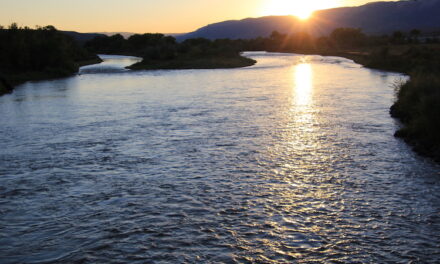by Terry Scanga, general manager, and Chelsey Nutter, projects manager
Upper Arkansas Water Conservancy District
Excluding the Northwest, lands of the United States west of the 100th meridian have often been coined the “Great American Desert” due to their aridity. Colorado and the Arkansas River Basin are no exception. Perhaps the driest spot as one progresses westward on the Arkansas is near Salida.
Today we are again faced with a dry year. This is not abnormal but rather a continuation of the normal and ongoing fluctuations we’ve always experienced with annual precipitation. Our predecessors here in Colorado knew this and developed a water allocation system that has worked well for over 100 years. It is called the Prior Appropriation system or, the “Colorado Doctrine.”
Years when water is in short supply, those water rights that were established earlier in time have the more senior priority. We call this “first in time, first in right.” This system is widely used throughout the arid west and has been replicated by other countries in the world with similar climates. Although this is an efficient water allocation system, the system does not prevent the negative impacts of drought. These impacts are, however, mitigated by proper planning and management.
The norm in the Arkansas Basin is deficit irrigation. This occurs when less than a full water supply is available for a crop. Irrigators with less senior rights, also known as junior water rights, understand water will not be available the entire growing season and plan accordingly. With a severe drought, such as in 2002, many of the irrigators with junior rights had no water. Others with relatively senior rights were curtailed sooner than normal, which resulted in less crop production.
Normally, the impact to agriculture is higher prices for forage and produce. Ranchers will respond by reducing their herd size by selling off some animals. This sell-off tends to temporarily reduce the price of cattle while forage price rates rise. Most irrigators develop long-term financial plans and are in business for the long-term, knowing that drought is part of the reality of agriculture in the arid West.
Municipalities and irrigation and conservancy districts plan for drought by developing systems around senior water rights that produce a known, firm water supply for drought periods. These senior rights coupled with reservoir storage and a diverse portfolio of native and transmountain water supplies provide resiliency and reliability during drought.
Additionally, conservation plans combined with storage provide additional drought protection. The curtailment of certain water uses, such as reductions in outside irrigation in municipalities, increasing block-rate pricing structures and use of water-efficient fixtures and infrastructure are methods used to force conservation, which provide a buffer for water supply constraints brought on by drought.
In some areas of Colorado drought has been more severe and of longer duration. Some irrigators have responded to back-to-back years of drought by changing from crops with higher water consumption to those with a smaller irrigation water requirement. For some crops it simply takes less water to reach maturity, and in these areas the major crops may indeed change permanently.
How severe is the present drought? The Natural Resource Conservation Service analyzes and predicts stream flows at various locations throughout the basin based upon annual precipitation. From June through September, the 30-year average total stream flow that passes through the Arkansas River at Salida is 230,000 acre-feet.
On June 1, 2018, the NRCS analysis showed that there was a 50 percent probability that the total stream flow for the same period would be 48 percent of the 30-year average, or 111,000 acre-feet. In 2002, the driest year on record, that total actual stream flow was 65,490 acre-feet, or 28 percent of the 30-year average. The 2002 actual stream flow is 59 percent of this year’s forecast.
This year we are also better off than 2002 with reservoir storage levels. In 2002 reservoir storage was at 66 percent of average, while this year it is at 127 percent of average. It appears that taking all things into account, the 2002 drought was more severe and covered the entire state of Colorado.
As the demand for water supply continues to increase with the increase in population, new and better forms of storage and management will become imperative. Accordingly, the Upper Arkansas Water Conservancy District is developing better and more timely water measurements to increase system efficiency.
The district is also developing storage that is subject to less evaporative loss, such as alluvial (underground) storage, and is continuing to build a more diversified water supply portfolio. It is also studying how to create temporary water supplies through lease fallowing sources and exploring other innovative projects.
One thing is certain ‒ in Colorado we are either going into a drought or coming out of one.












Recent Comments